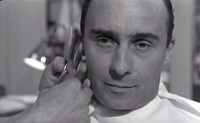André Delvaux often spoken passionately and poignantly of the unique bicultural experience that had infused early Belgian cinema (an industry that also fostered other pioneering bicultural filmmakers such as social realist – and undoubted spiritual ancestor to the cinema of Jean-Pierre and Luc Dardenne – Paul Meyer) that had become increasingly regionalized towards the end of the twentieth century, and to this day continues to wear away the remaining traces of a truly indigenous cinema. One side of the country’s complex native identity is the infusion of the centuries old, rich history of Flanders art and literature that, curiously, had not been able to translate into an equally distinctive movement within the evolution of Flemish cinema and remains a largely marginalized film industry, even within its own borders. Another side of this culturally erosive regionalization is the increasing international prominence of regional French language films from Wallonia and Brussels that have benefited in part from cooperative financing and support from other Francophone countries (most notably, in terms of wider distribution) in the absence of national funding – as represented by such renowned filmmakers as Chantal Akerman, the Dardenne brothers, and Jaco van Dormael – that, to a certain extent, have become a kind of de facto representative, collective face of Belgian national cinema to international audiences. But before domestic films would evolve into this divisive notion of dominant and marginalized regional cinemas, Delvaux worked integrally and organically from within both Flemish and Francophone cultures under the creative inspiration of a cross-pollinated, overarching national cinema that would accurately reflect the true essence of a bicultural Belgian identity.
This theme of biculturalism and complex identity would continue to resurface throughout Delvaux’s career, beginning with his elegant and quietly devastating first film, The Man Who Had His Hair Cut Short, based on Flemish author Johan Daisne’s vaguely Lolita-esque, stream of consciousness, magical realist novel on a fastidious, middle-aged schoolteacher who harbors a secret obsession for one of his students: a beautiful, aspiring actress named Fran (Beata Tyszkiewicz). Although told from the sole perspective of the hypersensitive, obsessed teacher, Gottfried “Govert” Miereveld’s (Senne Rouffaer) alienated – and increasingly alien – point of view, Delvaux illustrates this intrinsic complexity of identity through the film’s radical narrative and tonal shifts as Miereveld’s emotional and psychological torment over his inability to reveal his true feelings on the day of Fran’s graduation is structurally reflected through a series of elliptical, seemingly decontextualized fractures in narrative that occur throughout (and grows increasingly more frequent towards the end of) the film. Using an extended tracking shot of Miereveld walking home to a different, more modest house, Delvaux reinforces the depth (if not shock) of the unremarkable hero’s existential transformation after he undertakes a mid-career change following Fran’s departure from his life. Now working as a law clerk after a brief, but unsuccessful career as a trial lawyer, Miereveld accompanies the medical examiner, Professor Mato (Hector Camerlynck) and his assistant Dr. Verbrugge (Paul S’Jongers) as a reluctant state witness for an autopsy and possible positive identification of a body that has washed up in a remote village, a traumatic experience that profoundly shakes Miereveld’s consciousness and leads to a fateful encounter with the elusive object of his obsession.
In this respect, Miereveld’s self-reinvention throughout the film not only illustrates the trauma of repression, as an overwhelming sense of rejection and failure propel him to a state of fugue, but more importantly, also reflects Delvaux’s recurring preoccupation with the theme of complex identity as his existence devolves into a series of (real or imagined) role-playing rituals that, nevertheless, reveal his intrinsic character. Despite the imbalancing fragmentation of the narrative, Delvaux’s subtle assimilation of recursive patterns that weave throughout the seemingly disconnected episodes in Miereveld’s life reflect an intrinsic cohesiveness within the singularity of Miereveld’s perspective and provide insight into the (a)logical structure of his seemingly fractured and aimless life: the image of a scalp vibromassage that caps off a haircut at the barbershop at the beginning of the film is referenced during a procedural conversation into the specialized mechanism that drives a hand-operated cranial saw; the eerie placement of a mask on a covered table in the school storage room is visually replicated in the (alluded) position of the exhumed cadaver; the ceremonial presentation of a figurine in the shape of a gestured hand to a departing teacher is evoked in the disarticulation of the cadaver during the autopsy (and in the enumeration of physical characteristics that would aid in the identification of a missing bank manager) as well as serve as a tangible link to Fran and their shared past; a hotel staircase that subsequently serves as a background for a newsreel interview. This theme of abstractly threaded logic, psychological manifestation, and fractured cohesiveness inevitably shapes the indelible, otherworldly images of Delvaux’s minimalist and remarkably groundbreaking film – an idiosyncratic syntax that anticipates the allusive, disjunctive cinema of Apichatpong Weerasethakul (who similarly uses abrupt narrative shifts and extended traveling sequences as transitional devices in such films as Blissfully Yours and Tropical Malady) and reflexive, bifurcated cinema of Hong Sang-soo – even as it presents a metaphoric – and hauntingly prescient – cautionary tale on isolation and the rupture of identity.
© Acquarello 2006. All rights reserved.
